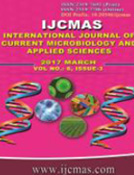


 National Academy of Agricultural Sciences (NAAS)
National Academy of Agricultural Sciences (NAAS)

|
PRINT ISSN : 2319-7692
Online ISSN : 2319-7706 Issues : 12 per year Publisher : Excellent Publishers Email : editorijcmas@gmail.com / submit@ijcmas.com Editor-in-chief: Dr.M.Prakash Index Copernicus ICV 2018: 95.39 NAAS RATING 2020: 5.38 |
Chickpea (Cicer arietinum L.) is one of the major rabi pulse crop and is a cheap source of protein. It has also advantages in the management of soil fertility particularly in dry lands and the semiarid tropics. Despite of low productivity of chickpea is attributed to Fusarium wilt disease which caused by obligate biotroph Fusarium oxysporum f.sp. ciceri is consider one of the major limiting factor. Experiment was conducted for find out the in-vitro efficacy of bioagents and phytoextracts against Fusarium oxysporum f.sp. ciceri. Out of different bioagents tested, T. harzianum gave maximum inhibition (79.63 %) of mycelia growth of test fungus followed by T. koningii with 77.78 % inhibition and least effective is G. virens with 55.93 % inhibited fungus growth. In different phyoextracts tested, A. indica showed highest inhibition (16.30 %, 34.56 % and 52.59 %) of test fungus in spite of 2 %, 5% and 10 % respectively compare to others. This was followed by L. camera with 12.59%, 29.83% and 44.23 % and lowest inhibition found J. gossypifolia with 4.44 %, 19.26 % and 35.64 % in terms of 2 %, 5% and 10 % respectively. The above findings are very useful for the farmers for making decision over the use of bio based fungicides for management of wilt disease which is safe management practice for environment.
 |
 |
 |
 |
 |